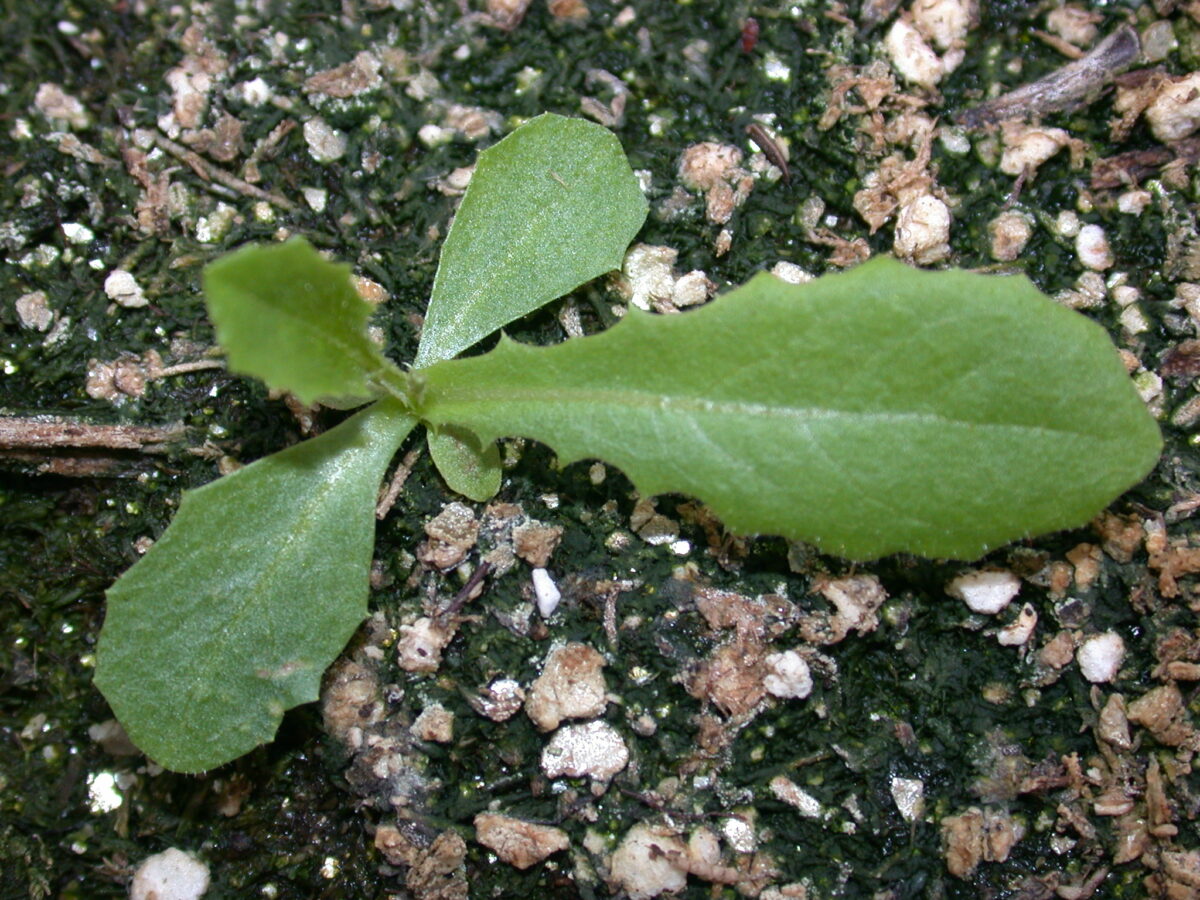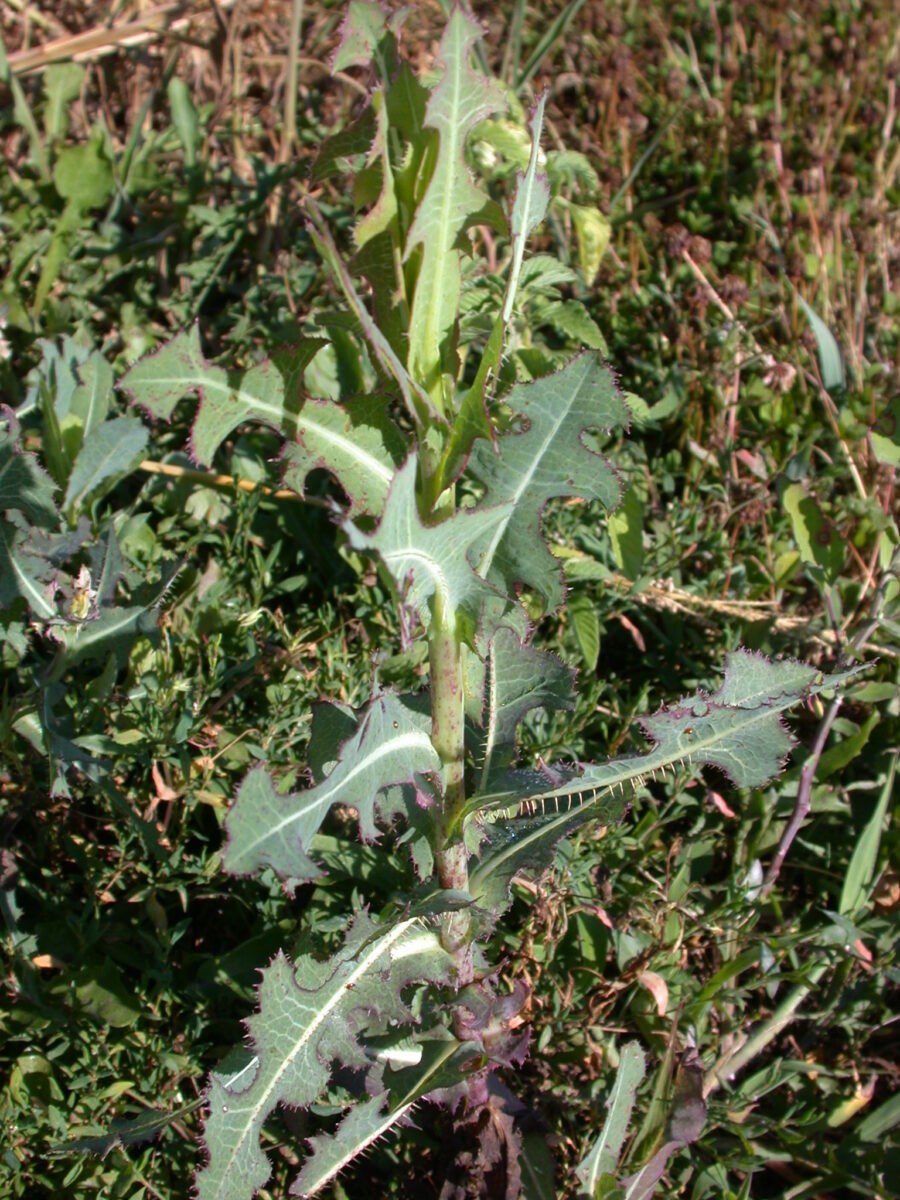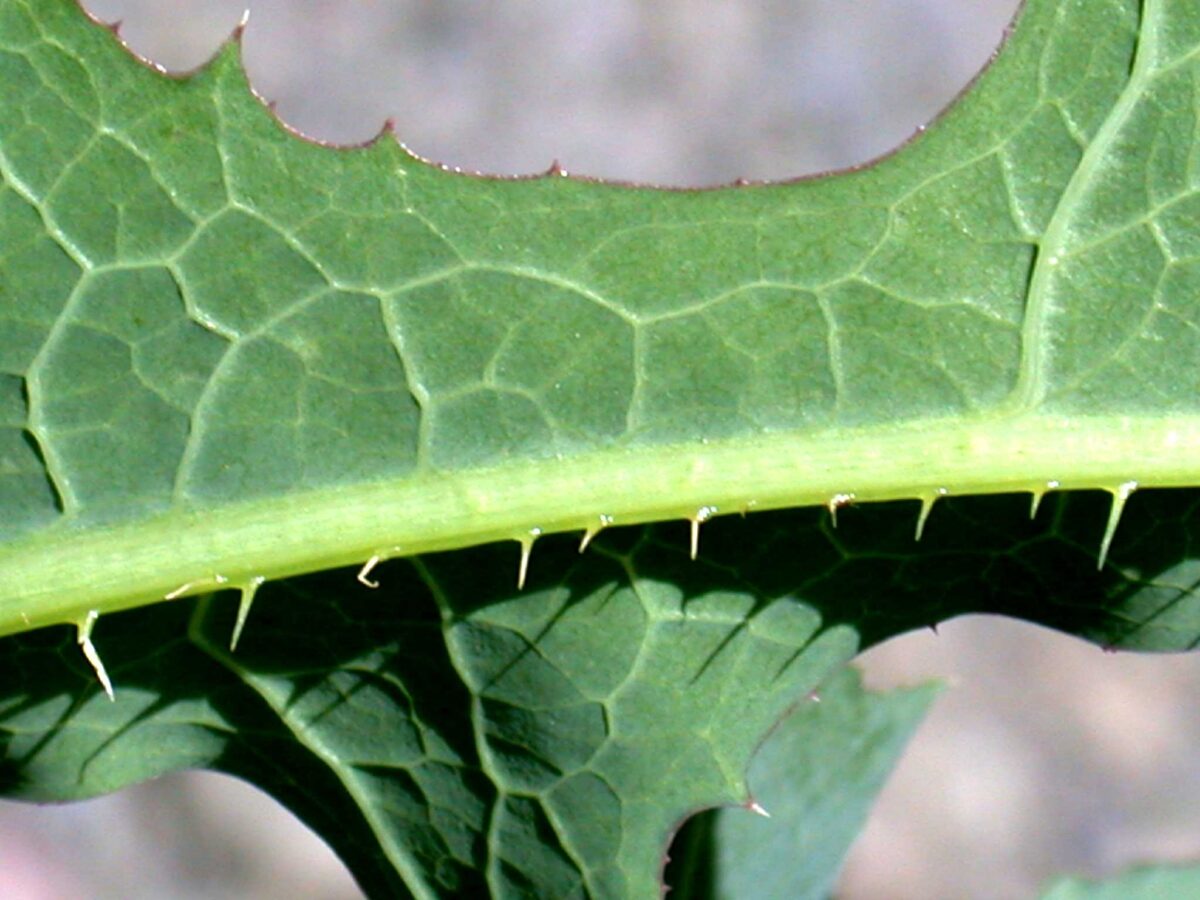Other common names: wild lettuce, compass plant, milk thistle, horse thistle, wild opium, common wild lettuce, lobed prickly lettuce



Lactuca serriola L.
Identification of Prickly Lettuce
Family: Aster family, Asteraceae
Habit: Erect, taprooted, summer or winter annual herb
Description: Seedling cotyledons are round or oval shaped and 0.2–0.4 inch long by 0.1 inch wide, with a tapering base, hairy upper surfaces and a notched tip. Young true leaves form a basal rosette; they are club to oval shaped, widest at the tip, pale green, hairy and toothed or lobed; spines are present on the undersides of the prominent midveins and on leaf edges. Mature plants bolt with erect, 1–6 foot-high, hollow, branched, somewhat woody stems. Stems are pale green to white, sometimes with red flecking, and spines are present at the stem base. Leaves are alternate, deeply lobed, blue-green, widest near the pointed leaf tip, 2–12 inches long by 1–4 inches wide, and often oriented vertically. Lobes point backward, form round cavities and clasp the stem at the leaf base. Mature spines on lower leaf surface and leaf edges are larger and more yellow than those found on the seedling. The entire plant, including the large, deep taproot, exudes a milky white sap when wounded. Flower heads are yellow but turn blue as they wither. They are 0.1–0.4 inch wide, composed of five to 15 ray flowers, and have three to four rows of hairless, 0.5 inch-long, green bracts covering the base. Flower heads occur in open pyramidal panicles of 13–27 inches at branch ends. One seed is produced per ray flower and enclosed in a dry, hard, grayish-yellow, 0.1–0.2 inch-long, ribbed fruit. This dispersal unit is referred to as the seed in the discussion below; it is attached by a 0.13 inch-long stalk to a white, bristly pappus.
Similar species: Sowthistle (Sonchus) species lack the characteristic midrib spines of prickly lettuce. Sowthistle leaves also remain parallel to the ground, unlike prickly lettuce.
Management of Prickly Lettuce
Prickly lettuce is primarily a problem in winter grains and reduced tillage cropping systems. The species is particularly a problem in cereal grains because it usually flowers at harvest, and the flower buds, which are difficult to separate from the grain, lower quality and raise moisture content. Since established plants can resprout after winter grain harvest operations, post-harvest control is advisable to prevent seed production.
Spring tillage controls plants that established in the fall, and late spring tillage controls most of the spring germinating individuals as well. Tillage that mixes seeds deep into the soil helps eliminate the weed. Since the seeds are small and short lived, few deeply buried seeds will return to emergence depth before they die. Control of populations along field margins may be necessary to prevent re-population by wind dispersed seeds.
The seedlings are weak and suffer high rates of natural mortality. Consequently, they are susceptible to tine weeding or rotary hoeing. They can also be controlled by flaming at the two- to four-leaf stage, but half of plants survive flaming at the six- to eight-leaf stage. Because prickly lettuce often grows taller than the crop at some point in development, it is susceptible to weed pullers, electrocution weeders and raised mowers.
Incorporated white mustard seed meal has the potential for allelopathically controlling prickly lettuce emergence and growth. Soil solarization to 135°F completely eliminates prickly lettuce emergence.
Ecology of Prickly Lettuce
Origin and distribution: Prickly lettuce is native to the Mediterranean basin and western Asia. It now occurs in northern Europe, central Asia, North America and Australia. In North America, it occurs throughout southern Canada, the United States and into northern Mexico, except the Florida peninsula.
Seed weight: Mean population seed weight ranges from 0.45–0.62 mg.
Dormancy and germination: Seeds have no primary dormancy and can germinate immediately following dispersal. Optimal temperature for germination in England was 54–75°F, and seeds did not germinate below 46°F. Temperatures from 79–95°F induced dormancy. Seeds from the Czech Republic germinated well at temperatures from 50–86°F. Sunlight promotes germination of fresh seeds, but light filtered through a plant canopy inhibits germination. After exposure to natural alternating temperatures and/or burial for at least eight weeks, however, seeds germinate well in the dark.
Seed longevity: Seeds in the soil normally do not survive longer than three years. In Idaho, prickly lettuce seeds on the soil surface did not survive longer than 12–18 months, whereas those buried 6 inches survived up to 24–33 months. Prickly lettuce seeds’ viability was an estimated 15–37% after 12 months burial. In England, the half-life of prickly lettuce seeds in soil was estimated to be 18 months, and mortality after 12 months was estimated to be 40%.
Season of emergence: Most plants emerge in the late fall, but a few emerge in the spring. Natural seedling mortality is much higher for fall germinating plants.
Emergence depth: Seeds emerge best when covered by no more than a thin layer of dust. Emergence at 0.8 inch is less than 25% of that near the soil surface.
Photosynthetic pathway: C3
Sensitivity to frost: Prickly lettuce is very frost tolerant and commonly overwinters as a rosette, even in the northern parts of its range. During midwinter in Illinois, leaves reached temperatures as much as 18°F above air temperature. This allows continued growth on sunny winter days.
Drought tolerance: Prickly lettuce is highly drought tolerant. Its taproot extends 3 feet or more, and it can therefore tolerate drying of the plow layer. Prickly lettuce has greater taproot length per unit plant weight, number of lateral roots per unit taproot and lateral number near the bottom of the taproot compared to cultivated lettuce. The leaves orient vertically in a north-south plane, which allows maximum photosynthesis early and late in the day while reducing overheating and water stress at mid-day.
Mycorrhiza: Prickly lettuce is mycorrhizal.
Response to fertility: The limited information available seems to indicate that prickly lettuce is favored by additions of P and K but is out-competed by N-responsive species when N or a balanced nutrient source is applied.
Soil physical requirements: The species occurs on all soil textures from gravelly sand to clay. It is most common on dry, well drained soils, but it also occasionally occurs in wet sites.
Response to shade: Prickly lettuce, particularly in the rosette stage, is suppressed by a dense crop leaf canopy and suffers high mortality rates.
Sensitivity to disturbance: If mowed during flowering, the plant will branch from the remaining stem and flower again. Plants cut during winter wheat harvest in Ontario, produced 500–3,000 mature seeds per plant by late October if left unmanaged.
Time from emergence to reproduction: Overwintering plants begin to elongate in May and flower from July to September. Most seeds are shed during August and September. Spring germinating individuals mature only one to two weeks later than plants establishing in the fall. Plants that began flowering in the last week of July produced viable seeds by August 17, indicating approximately three weeks were required for maturation. Low temperature vernalization of rosettes at 40–50°F is necessary to trigger flowering.
Pollination: Prickly lettuce primarily self-pollinates, but insects accomplish some cross pollination.
Reproduction: Seed heads typically contain from 15–22 seeds. Seed production depends on plant height. For plants growing in soybeans and grain stubble in Ontario, 1 foot plants produced about 330 seeds whereas 5 foot plants produced about 55,000 seeds. Mid-sized plants of 40 inches produced 6,700 seeds. In Idaho, plants averaged 4,200–4,900 seeds per plant. In a British study, fall germinating plants averaged 1,550–2,350 seeds each, whereas spring germinating plants averaged 170–1,500 seeds each, with later emerging plants producing fewer seeds.
Dispersal: The seeds have a clump of hairs at the top that provide buoyancy in air and assist in wind dispersal. Although a very few seeds may travel long distances, most fall close to the parent plant. Seeds also disperse by water and can be introduced into fields with surface irrigation water.
Common natural enemies: Downy mildew (Bremia lactucae) can infect a high proportion of prickly lettuce populations, but disease severity is usually low relative to that on cultivated lettuce. Powdery mildew (Erysiphe cichoracearum) can cause more extensive infection and may reduce seed production under favorable conditions.
Palatability: Although prickly lettuce is the wild ancestor of the domestic lettuce, it is very bitter and unpalatable to people, even when young. Cattle can develop emphysema from feeding on fresh, young plants, but dried or mature plants are apparently not toxic.
Summary Table of Prickly Lettuce Characteristics
| Prickly Lettuce | ||||||||
|---|---|---|---|---|---|---|---|---|
| Growth habit | Seed weight (mg) | Seed dormancy at shedding | Factors breaking dormancy | Optimum temperature for germination (F) | Seed mortality in untilled soil (%/year) | Seed mortality in tilled soil (%/year) | Typical emergence season | Optimum emergence depth (inches) |
| medium, erect | 0.45–0.62 | No | li, at | 54–75 | 40–85 | na | fall and spring | 0–0.1 |
| Photosynthesis type | Frost tolerance | Drought tolerance | Mycorrhiza | Response to nutrients | Emergence to flowering (weeks) | Flowering to viable seed (weeks) | Pollination | Typical & high seed production (seeds per plant) |
| C3 | high | high | yes | moderate | 8–12 | 3 | self, can cross | 5,000 & 50,000 |
Table Key
General: The designation “–” signifies that data is not available or the category is not applicable.
Growth habit: A two-word description; the first word indicates relative height (tall, medium, short, prostrate) and second word indicates degree of branching (erect, branching, vining).
Seed weight: Range of reported values in units of “mg per seed.”
Seed dormancy at shedding: “Yes” if most seeds are dormant when shed, “Variable” if dormancy is highly variable, “No” if most seeds are not dormant.
Factors breaking dormancy: The principle factors that are reported to break dormancy and facilitate germination. The order of listing does not imply order of importance. Abbreviations are:
scd = seed coat deterioration
cms = a period subjected to cold, moist soil conditions
wst = warm soil temperatures
li = light
at = alternating day-night temperatures
ni = nitrates
Optimum temperature range for germination: Temperature (Fahrenheit) range that provides for optimum germination of non-dormant seeds. Germination at lower percentages can occur outside of this range. The dash refers to temperature range, and the slash refers to alternating day/night temperature amplitudes.
Seed mortality in untilled soil: Range of mortality estimates (percentage of seed mortality in one year) for buried seeds in untilled soil. Values were chosen where possible for seeds placed at depths below the emergence depth for the species and left undisturbed until assessment. Mortality primarily represents seed deterioration in soil.
Seed mortality in tilled soil: Range of mortality estimates (percentage of seed mortality in one year) for seeds in tilled soil. Values were chosen for seeds placed within the tillage depth and subjected to at least annual tillage events. Seed losses are the result of dormancy-breaking cues induced by tillage, germination and deterioration of un-germinated seeds.
Typical emergence season: Time of year when most emergence occurs in the typical regions of occurrence for each weed. Some emergence may occur outside of this range.
Optimum emergence depth: Soil depths (in inches below the soil surface) from which most seedlings emerge. Lower rates of emergence usually will occur at depths just above or just below this range.
Photosynthesis type: Codes “C3” or “C4” refer to the metabolic pathway for fixing carbon dioxide during photosynthesis. Generally, C3 plants function better in cooler seasons or environments and C4 plants function better in warmer seasons or environments.
Frost tolerance: Relative tolerance of plants to freezing temperatures (high, moderate, low).
Drought tolerance: Relative tolerance of plants to drought (high, moderate, low).
Mycorrhiza: Presence of mycorrhizal fungi. “Yes” if present; “no” if documented not to be present, “unclear” if there are reports of both presence and absence; “variable” if the weed can function either with or without, depending on the soil environment.
Response to nutrients: Relative plant growth response to the nutrient content of soil, primarily N, P, K (high, moderate, low).
Emergence to flowering: Length of time (weeks) after emergence for plants to begin flowering given typical emergence in the region of occurrence. For species emerging in fall, “emergence to flowering” means time from resumption of growth in spring to first flowering.
Flowering to viable seed: Length of time (weeks) after flowering for seeds to become viable.
Pollination: “Self” refers to species that exclusively self-pollinate, “cross” refers to species that exclusively cross-pollinate, “self, can cross” refer to species that primarily self-pollinate, but also cross-pollinate at a low rate, and “both” refers to species that both self-pollinate and cross-pollinate at relatively similar rates.
Typical and high seed production potential: The first value is seed production (seeds per plant) under typical conditions with crop and weed competition. The second value, high seed production, refers to conditions of low density without crop competition. Numbers are rounded off to a magnitude that is representative of often highly variable reported values.
Further Reading
Marks, M.K. and S.D. Prince. 1982. Seed physiology and seasonal emergence of wild lettuce Lactuca serriola. Oikos 38: 242–249.
USDA. 1970. Selected Weeds of the United States. United States Department of Agriculture, Agricultural Research Service, Agriculture Handbook No. 366. U.S. Government Printing Office: Washington, DC.
Weaver, S.E. and M.P. Downs. 2003. The biology of Canadian weeds. 122. Lactuca serriola L. Canadian Journal of Plant Science 83: 619–628.

